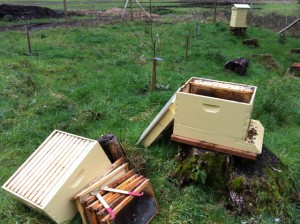We got a sunny day today, for the first time in a while. It gave me a chance to go out and check up on my bees, when the cold wouldn’t be too harmful to them if I poked around. Hive A, the one that nearly died from varroa last fall, was going great- some bees were bopping around, coming and going, burning off a little of that cabin fever. There were even a few drones to be seen, which is pretty ambitious this early in the year.
The next two hives were not as happy, though. No activity. Sometimes the bees don’t want to venture out until they’re SURE the winter is over, but this didn’t look good. What you do in this situation is give a sharp rap on the side of the hive, then put your ear against the wood. If anyone’s home, they say something like “grumble grumble grumble” then go back to being quiet. No one said that in hives B and C.
So, cold or not, I opened them up. Both are dead. 🙁 The next step was to disassemble them, performing the cleaning/autopsy that is the standard procedure in this situation. Hive B, the one that I had to requeen last fall, seemed to be the classic case of winter starvation: their honey supply ran out, as evidenced by sad little bee corpses with their tongues lolling out, and others with their butts poking out of cells where they were trying to scrape the last of the honey out when they expired. I learned a lesson here: I kept a feeder of sugar syrup on them all winter, but sometimes bees don’t want to “break cluster” and travel six inches away to get it. Some beekepers make a special bee-candy and stick it right into the hive, so I’m going to try that next year.
 The greatest mystery is Hive C, the feral colony I pulled out of a toolshed last summer. They were building up like crazy all summer, and looked strong until recently. The autopsy revealed bees with their butts sticking out of the comb, a standard sign of starvation… but they had nearly a full super of honey in their combs. What does it mean? I talked to Terry, and he says that this sometimes just happens. Beekeeping is mysterious.
The greatest mystery is Hive C, the feral colony I pulled out of a toolshed last summer. They were building up like crazy all summer, and looked strong until recently. The autopsy revealed bees with their butts sticking out of the comb, a standard sign of starvation… but they had nearly a full super of honey in their combs. What does it mean? I talked to Terry, and he says that this sometimes just happens. Beekeeping is mysterious.
So, after I cleaned out all of the dead equipment, I put it away to be reused in a month when the new bees arrive. I added the extra honey from the feral colony to the top of Colony A, my survivors, as an extra insurance policy. I am sure they will enjoy it.
Am I sad? Yes. But that’s how farming goes. Recent apiary statistics show that the average beekeeper has been experiencing a ±30% winter loss for the last few years, due to a combination of varroa, other pests, chemicals, CCD, and some unknown factors. By that standard, I did one hive worse than the national average- not terribly reassuring. But thus is farming.
-ps: I’m leaving tomorrow morning for a week in Panama, to teach a weeklong beekeeping course at an orphanage. Wish me luck.

